| Areawide Suppression of Fire Ant Populations in Pastures |

|
The project "Areawide Suppression of Fire Ant Populations in Pasture" is a partnership between the USDA-ARS-Center for Medical, Agricultural, and Veterinary Entomology, USDA-ARS-Jamie Whitten Delta States Research Center , UDSA-APHIS-Gulfport Imported Fire Ant Station, University of Florida, Texas A&M University, Clemson University, and Oklahoma State University. This project was initiated in 2001 and has continued through the present day.
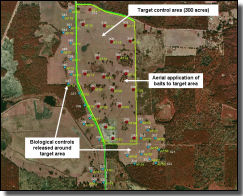
Aerial view shows a pasture site used for Areawide study in Florida. Fire ant populations within and around treatment area were monitored for five years after bait applications and biological control agents were released.
|
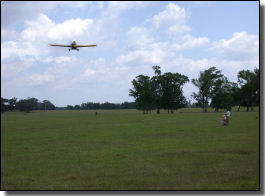
Aerial application of fire ant bait to 300 acre pasture
|
The project's goal is to demonstrate an integrated fire ant control program using self-sustaining biological control agents (decapitating flies, Pseudacteon spp., and protozoan, Thelohania solenopsae) and chemical baits. Chemical baits were used to reduce the fire ant population and applied as needed through the course of 5 years. The biocontrol agents were introduced to pasture sites to slow, limit, or prevent reinfestation of the treated area. This integrated approach is expected to keep fire ant populations from causing a financial burden on farmers and ranchers, or ecological damage to native wildlife as well as establish natural enemies of fire ants within the United States. Data on fire ant populations at all field sites have been collected and are currently being analyzed.
Large sites (ca. 300 acres) were established in FL, TX, OK, SC, and MS to allow testing of the integrated approach under different climatic and environmental conditions. The biological control agents have been introduced in the demonstration areas, and chemical baits have been applied to designated areas. To date, Thelohania solenopsae has been released and established throughout the Areawide sites. In addition, two species of Pseudacteon spp. decapitating flies have also been released and established at Areawide pasture sites and the flies are expanding their range. USDA is conducting further research into additional species of decapitating flies for eventual release against fire ants.
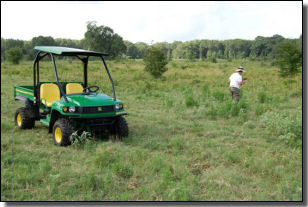
|
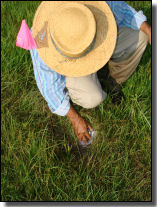
|
|
Monitoring fire ant activity in Texas (left) and Florida (right) pasture sites
|
|
Besides evaluating the fire ant population and activity, both environmental and economic assessments were conducted. When fire ants are controlled, populations of native ants, which do not cause problems, increased and serve as further obstacle to fire ant re-infestation. Lowering fire ant populations can increase farmers' profit by decreasing production costs associated with ant control, equipment damage and repairs, and loss of use. Five years of economic and environmental data have been collected and are being processed.
Besides the field demonstration aspect, several research components are part of the Areawide project. These include the development of a fire ant-specific bait system, a phorid fly detection trap system using fire ant semiochemicals, and a method for detection of T. solenopsae in samples using immunological or genetic methods. Research will also continue on the identification, isolation, testing, and mass production of new biocontrol agents that can be released for control of fire ants.
Some of the expected outcomes of the Areawide fire ant project include:
- Improved recommendations for applications of bait combination (hydramethylnon + methoprene) in pastures and an integrated fire ant control strategy that can be adapted to other agricultural and urban systems;
- Methodologies for efficient production, formulation, release, spread and detection of the biocontrol agents used in fire ant control;
- Release, establishment and spread of biological controls within demonstration areas and elsewhere in cooperating states;
- Sustained fire ant control with lower livestock production costs, increased farm-worker safety, and reduced pesticide risk;
- Restored ecological balance among native ants, birds, and wildlife.
High Value Demonstration Sites
In addition to large pastures, high-value demonstration sites were established within each of the cooperating states. These high-value sites were designated as sites where fire ants inhibit site use, are aesthetically damaging, or may potentially injure site managers or end users. Areawide co-operators work with property owners and managers to develop an efficient and effective management strategy that maximizes treatment efficacy and minimizes associated costs, labor, and risks. This customized management plan may then be adopted by property managers for long-term management of fire ants or adapted for control of fire ants at similar properties.
Examples of high value demonstration sites include schools, public cemeteries, public parks (state, city, and/or county), picnic areas, wildlife habitats, and golf courses.
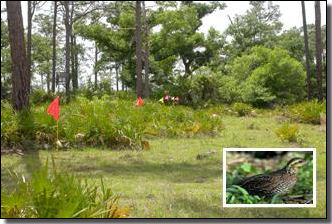 Treatment and monitoring of fire ant populations within habitat for Northern Bobwhite Quail (insert). Areawide cooperators are working with property managers to develop treatment strategies that protect vulnerable young quail from fire ants during their nesting season.
Treatment and monitoring of fire ant populations within habitat for Northern Bobwhite Quail (insert). Areawide cooperators are working with property managers to develop treatment strategies that protect vulnerable young quail from fire ants during their nesting season.
|
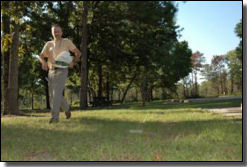 Itchetucknee Springs State Park is a significant revenue-generating park for the Florida Department of Environmental Protection, who manages over 200 parks statewide. Environmentally sensitive treatments are needed to reduce fire ant populations during peak summer months when the park may host thousands of visitors per day.
Itchetucknee Springs State Park is a significant revenue-generating park for the Florida Department of Environmental Protection, who manages over 200 parks statewide. Environmentally sensitive treatments are needed to reduce fire ant populations during peak summer months when the park may host thousands of visitors per day.
|
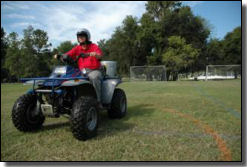 Kanapaha Park is a multi-purpose facility located near one of the fastest-growing regions of Gainesville, FL. Alachua County Public Works Department, who manages 26 parks, is interested in cost-effective fire ant control that works.
Kanapaha Park is a multi-purpose facility located near one of the fastest-growing regions of Gainesville, FL. Alachua County Public Works Department, who manages 26 parks, is interested in cost-effective fire ant control that works.
|
 Monitoring fire ant activity (upper left) and conducting timely treatments is part of the plan to reduce fire ant abundance before the annual Veterans' Day celebration in Kanapaha Park. The Veterans' War Memorial is a central feature of Kanapaha Park (upper right; lower left; lower right) which hosts one of the largest Veterans' Day celebrations in northern Florida. |
Awards & Recognition for the Areawide Program
The Areawide Program has been received a Technology Transfer Award: Superior Rating, as well as Honorable Mention by the Southeast Federal Laboratory Consortium.
